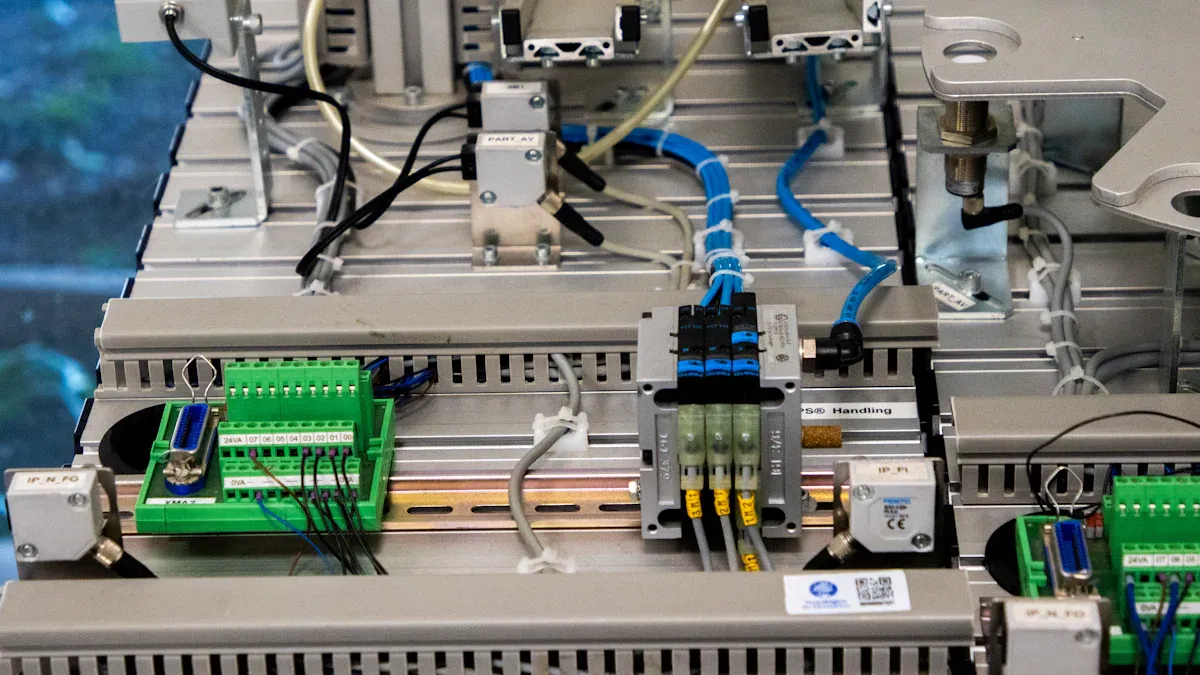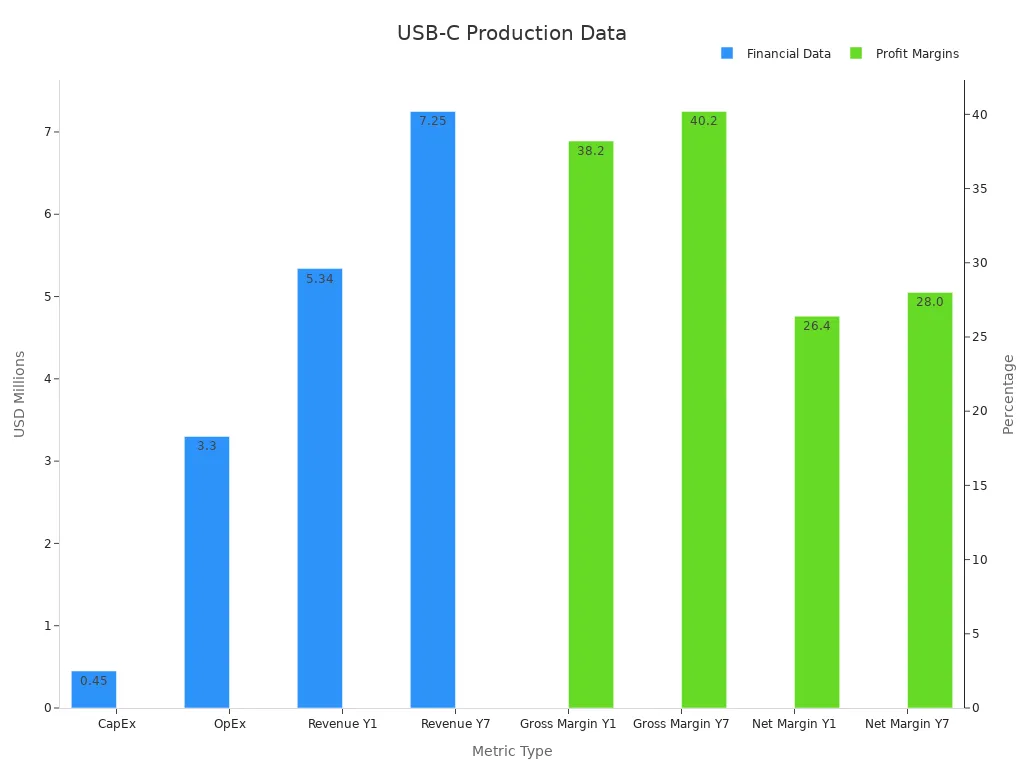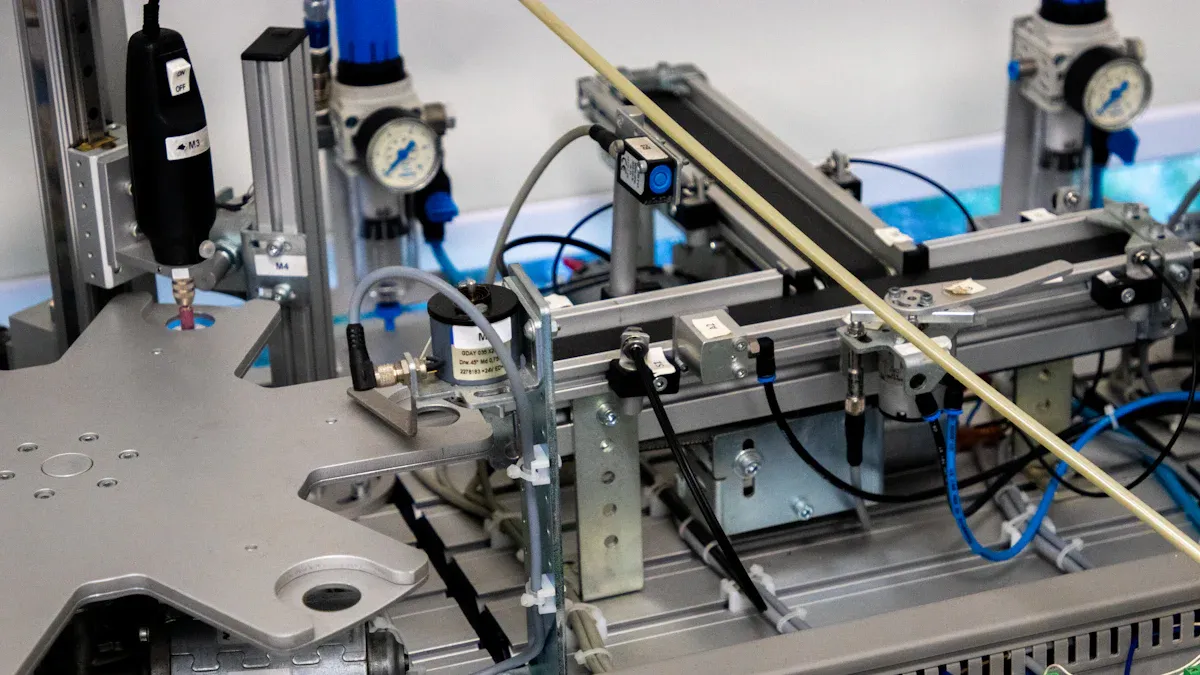In a USB-C cable factory, quality control plays a vital role in delivering reliable products. It ensures each cable you use meets the highest safety and performance standards. Without rigorous checks, faulty cables could compromise charging efficiency or even cause safety hazards. For instance, advanced tools like the Advanced Cable Tester v2 measure signal integrity and pinpoint defects, ensuring each cable performs as expected. By testing every unit, manufacturers prevent subpar cables from reaching your hands, safeguarding both charging reliability and compliance with industry standards.
Overview of USB-C Cable Manufacturing
Components of a USB-C Cable
A USB-C cable is more than just a simple wire. It contains several critical components that ensure compatibility, efficient data transfer, and reliable power delivery. These include:
– VBUS wires for power delivery.
– Ground (GND) wires for return paths.
– Differential pairs (D+ and D-) for USB 2.0 data transfer.
– SuperSpeed differential pairs (RX and TX) for USB 3.0 and higher speeds.
– Configuration Channel (CC) wires for managing power delivery and protocols.
– Sideband Use (SBU) wires for Alternate Modes like HDMI.
– VCONN wires for powering active cables with built-in electronics.
High-quality cables often include advanced chips, such as E-Marker chips for USB 4 cables or Intel-certified Cypress chips for Thunderbolt 4 interfaces. These components ensure your USB-C devices perform optimally and remain safe during use.
Steps in the Manufacturing Process
Manufacturers follow a precise process to produce USB-C cables that meet industry standards. The steps include:
1. Cutting the Cables: Raw cables are cut to the required lengths.
2. Exposing the Inner Conductor: The outer jacket is stripped to reveal the inner wires.
3. Connecting the Wire and Terminal: Wires are soldered to the connector terminals.
4. Molding: Injection molding covers the connections for durability.
5. Final Checking and Packaging: Each cable undergoes electrical testing and visual inspection before packaging.
This streamlined process allows manufacturers to produce up to 480,000 USB-C cables annually, as shown in the table below:
| Metric | Value |
|---|---|
| Production Capacity | 480,000 USB data cables/year |
| Capital Investment (CapEx) | USD 0.45 Million |
| Operating Expenditure (OpEx) | USD 3.30 Million (Year 1) |
| Revenue (Year 1) | USD 5.34 Million |
| Revenue (Year 7) | USD 7.25 Million |
| Gross Profit Margin (Year 1) | 38.2% |
| Gross Profit Margin (Year 7) | 40.2% |
| Net Profit Margin (Year 1) | 26.4% |
| Net Profit Margin (Year 7) | 28.0% |
Common Challenges in USB-C Cable Production
Despite advancements, USB-C cable production faces challenges. One common issue is the omission of 5.1 kΩ pulldowns on USB-C ports, which can prevent devices from charging properly. This often results from cost-cutting measures during design. Another example is the Apple 30W USB-PD charger (Model A1882), which failed compliance with the Type-C R2.0 specification due to a bug in its Finite State Machine. Such oversights highlight the importance of rigorous quality control to ensure compatibility and user satisfaction.
Quality Control Steps in a USB-C Cable Factory
Material Inspection and Sourcing
The quality of a USB-C cable begins with the materials used. Manufacturers carefully inspect raw materials to ensure they meet strict standards. For example, the copper wires must have high conductivity to support efficient power delivery and data transfer. The plastic used for insulation and the outer jacket must be durable and resistant to wear. Before production starts, every batch of materials undergoes rigorous testing to confirm compatibility with USB-C devices.
Sourcing materials from reliable suppliers is equally important. Manufacturers often work with certified vendors who provide components like connectors and E-Marker chips. These components play a critical role in ensuring the cable’s compatibility with various devices and its ability to handle high-speed data transfer. By prioritizing material inspection and sourcing, manufacturers lay the foundation for producing high-quality USB-C cables.
Assembly Line Quality Checks
During production, manufacturers implement multiple quality checks on the assembly line. These checks focus on key processes like soldering wires to connectors and molding the cable’s outer jacket. Workers receive strict training before starting their tasks to ensure precision at every step. Inspections occur at critical stages to catch defects early and prevent faulty cables from advancing further in the process.
To enhance reliability, manufacturers conduct regular tests such as cable bending, temperature impact, and pull-in tests. These tests simulate real-world conditions to verify the cable’s durability and performance. The table below highlights some verified processes that improve product reliability in USB-C cable factories:
| Evidence Type | Description |
|---|---|
| Quality Control Certification | The factory holds ISO9001, ISO14001, and IATF16949 certifications, ensuring adherence to quality standards. |
| Reliability Testing Procedures | Regular tests such as cable bending, temperature impact, and pull-in tests are conducted to ensure reliability. |
| Final Product Inspection | A final inspection is performed on every product according to SQL standards, confirming quality before delivery. |
By maintaining these assembly line checks, manufacturers ensure that each USB-C cable meets industry standards for performance and safety.
Final Product Inspection and Testing
Before a USB-C cable leaves the factory, it undergoes a final round of inspection and testing. This step ensures that the finished product meets all quality benchmarks. Technicians test each cable for electrical performance, including its ability to handle power delivery and data transfer. They also check the connectors for proper alignment and secure attachment to the cable.
Final inspections follow SQL standards, which require a thorough evaluation of every unit. This process includes visual inspections to identify physical defects and functional tests to confirm compatibility with USB-C devices. By the time the cable reaches you, it has passed multiple layers of scrutiny to guarantee reliability and safety.
Tip: Always look for USB-C cables with certifications like USB-IF or Thunderbolt to ensure they have undergone rigorous testing.
Testing Methods and Industry Standards for USB-C Cables
Durability Testing Techniques
Durability testing ensures that a USB-C cable can withstand daily wear and tear. Manufacturers simulate real-world conditions to evaluate the cable’s strength and flexibility. These tests include bending, twisting, and pulling the cable repeatedly to check for damage. For example, a bending test involves flexing the cable at different angles to ensure it can handle frequent use without breaking. Pull tests measure the strength of the connector’s attachment to the cable, ensuring it remains secure during use.
A comparative analysis of durability testing results highlights the performance of various cables. The table below shows how different cables performed under flex tests:
| Cable Name | Durability Test Results | Observations |
|---|---|---|
| Anker PowerLine III | Passed 100+ flex tests with mild discoloration; no damage observed. | Impressive durability with a flexible design compared to braided options. |
| Cyvensmart | No damage after 100+ folds; reinforced strain relief and braided sheath. | Maintained integrity and functionality despite repeated flexing. |
| Belkin | Passed flex tests but showed creases and discoloration on the jacket. | Reinforced standard jacket provided increased durability, but some wear was evident. |
| Cable Matters | Similar to Belkin, reinforced but without a braided jacket; passed flex tests. | Durable construction with some visible wear after testing. |
| Other Cables | Most cables with braided sheaths showed no significant wear after testing. | Braided exteriors generally provided better protection against wear and tear during tests. |
When choosing a USB-C cable, look for features like braided exteriors and reinforced connectors. These features enhance durability and ensure the cable lasts longer, even with frequent use.
Electrical Performance Testing
Electrical performance testing evaluates a USB-C cable’s ability to handle power delivery and data transfer efficiently. These tests measure parameters like voltage, current, and signal integrity. For instance, a power delivery test ensures the cable can safely transfer the required power to your devices without overheating. Signal integrity tests check for data loss or interference during data transfer, ensuring compatibility with USB-C devices.
High-quality cables undergo rigorous electrical testing to meet the USB-C standard. This includes verifying the functionality of components like E-Marker chips, which manage power delivery and ensure compatibility with various devices. By passing these tests, a cable guarantees reliable charging functions and seamless data transfer.
USB-IF Certification and Compliance
USB-IF certification ensures that a USB-C cable meets industry standards for safety and performance. The USB Implementers Forum (USB-IF) introduced a compliance program to enhance the safety of USB-C products. This program prevents issues like overheating or device incompatibility, which can occur with uncertified cables.
Several case studies highlight the importance of USB-IF compliance. For example:
– A USB-PD enabled product, ‘Monitor X,’ failed due to the lack of USB-IF certification. This failure caused charging and compatibility issues.
– USB-IF certified components and compliance tests are recommended to avoid such failures.
When purchasing a USB-C charging cable, always check for USB-IF certification. This certification ensures the cable has undergone rigorous testing and meets the highest quality standards. Certified cables provide reliable performance, protect your devices, and comply with the USB-C standard.
Tip: Look for the USB-IF logo on the packaging to confirm the cable’s certification. This simple step can save you from potential device damage or performance issues.
Addressing Defects and Ensuring Continuous Improvement
Identifying and Categorizing Defects
Defects in USB-C cables can arise from various stages of production. Identifying these issues early ensures that faulty cables do not reach your devices. Manufacturers inspect USB-C connectors for scratches, deformation, and other flaws that could affect performance. Advanced tools, such as AI-enabled defect detection systems, enhance this process. These systems analyze multiple sides of the connector, accurately identifying defects that might go unnoticed during manual inspections. By categorizing these flaws, manufacturers can focus on improving specific areas of production.
For example, scratches on connectors may result from improper handling during assembly. Deformation could occur due to incorrect molding techniques. By classifying these defects, manufacturers can implement targeted solutions, ensuring the cables meet industry standards and function reliably with your devices.
Root Cause Analysis and Corrective Measures
When defects are identified, addressing their root causes becomes essential. Manufacturers use systematic approaches and statistical tools to uncover the underlying issues. Instead of applying superficial fixes, they focus on correcting the inputs that lead to the problem. For instance:
– Root cause analysis (RCA) prevents recurring issues by eliminating the primary sources of defects.
– Corrective actions improve system reliability and ensure long-term performance.
– Investing in sustainable solutions enhances the overall quality of USB-C cables.
By addressing root causes, manufacturers strengthen the production process. This approach reduces the likelihood of defects and ensures that the cables you use are safe and reliable.
Strategies for Continuous Improvement in USB-C Cable Factories
Continuous improvement is vital for maintaining high-quality standards in a USB-C cable factory. Manufacturers adopt proven strategies to enhance efficiency and reduce waste. These include:
– Lean Methodology: Streamlines production processes to minimize waste and improve performance.
– Planned Maintenance: Ensures equipment operates efficiently, reducing downtime.
– Autonomous Maintenance: Empowers workers to maintain machinery, leading to fewer interruptions.
– Overall Equipment Effectiveness (OEE): Tracks production efficiency, helping manufacturers identify bottlenecks. For example, implementing OEE metrics increased efficiency from 67.21% to 72.14%.
These strategies allow manufacturers to produce high-quality cables consistently. By focusing on continuous improvement, they ensure that the cables you rely on meet the demands of modern devices.
Quality control plays a crucial role in USB-C cable manufacturing. It ensures that every cable meets high standards for performance and safety. By implementing rigorous testing, manufacturers deliver reliable products that protect your devices and enhance your experience.
The benefits of quality control extend beyond the factory floor:
– Consumer Trust: Consistent quality builds confidence in the brand, much like a defect-free smartphone model strengthens customer belief in its reliability.
– Brand Loyalty: Industries like automotive show how rigorous testing fosters loyalty, as customers return to brands known for safety and dependability.
Maintaining high-quality standards ensures long-term success. It safeguards your satisfaction while reinforcing the manufacturer’s reputation for excellence.
FAQ
What makes USB-C cables different from other cables?
USB-C cables stand out due to their reversible design, faster data transfer rates, and higher power delivery capabilities. They support multiple protocols like HDMI and Thunderbolt, making them versatile for charging, data transfer, and video output.
How can you identify a high-quality USB-C cable?
Look for certifications like USB-IF or Thunderbolt. Check for features like braided exteriors, reinforced connectors, and E-Marker chips. These ensure durability, compatibility, and safe power delivery.
Tip: Avoid uncertified cables to protect your devices from overheating or damage.
Why is USB-IF certification important?
USB-IF certification guarantees that a cable meets industry standards for safety and performance. Certified cables undergo rigorous testing to ensure reliable charging, efficient data transfer, and device compatibility.
How do manufacturers test USB-C cables for durability?
Manufacturers perform bending, twisting, and pull tests to simulate real-world usage. These tests check the cable’s strength and flexibility, ensuring it can handle daily wear and tear without breaking.
Can a defective USB-C cable damage your device?
Yes, defective cables can cause overheating, short circuits, or data loss. Always choose cables with proper certifications and quality assurance to avoid potential risks.
Note: Investing in a certified cable protects your device and ensures long-term reliability.




